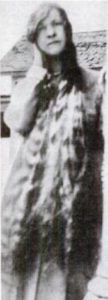 Mary Babnick Brown (1907 – 1991) was born in Colorado, the eldest of four children of Slovenian immigrants. She left school at age 12 to help support her family, and ended up working 42 years in a broom factory. She loved to dance, and taught G.I.s how to dance during World War 2.
Mary Babnick Brown (1907 – 1991) was born in Colorado, the eldest of four children of Slovenian immigrants. She left school at age 12 to help support her family, and ended up working 42 years in a broom factory. She loved to dance, and taught G.I.s how to dance during World War 2.
Brown had blonde hair to her knees that she washed with ordinary soap. It had never been cut, curled, or treated with chemicals. In 1943, she donated it to the war effort. She cried for two weeks after it was cut. The government offered her compensation, but she refused, saying giving up her hair was a patriotic duty. She was told it would be used for “meteorological instruments.”
The government needed a thin-stranded material that could withstand variable humidity and freezing temperatures without changing length or shape. They even experimented with spider webs.
The only thing that worked was fine blonde human hair that had never been chemically treated or curled with hot irons. It had to be at least 22 inches long.
 Mary Babnick Brown’s knee-length hair became a critical war material so secret she wasn’t told what it was actually used for until 44 years later, in 1987, when she was 80 years old. It was the crosshairs in Norden bombsights.
Mary Babnick Brown’s knee-length hair became a critical war material so secret she wasn’t told what it was actually used for until 44 years later, in 1987, when she was 80 years old. It was the crosshairs in Norden bombsights.
It turned out the super-secret Norden sight wasn’t very accurate in actual combat, which perhaps was just as well, because a German spy worked in the Norden plant and stole the design before the war began.
There’s one for sale (in used condition) on eBay for $4,995. I believe it comes with the crosshairs.